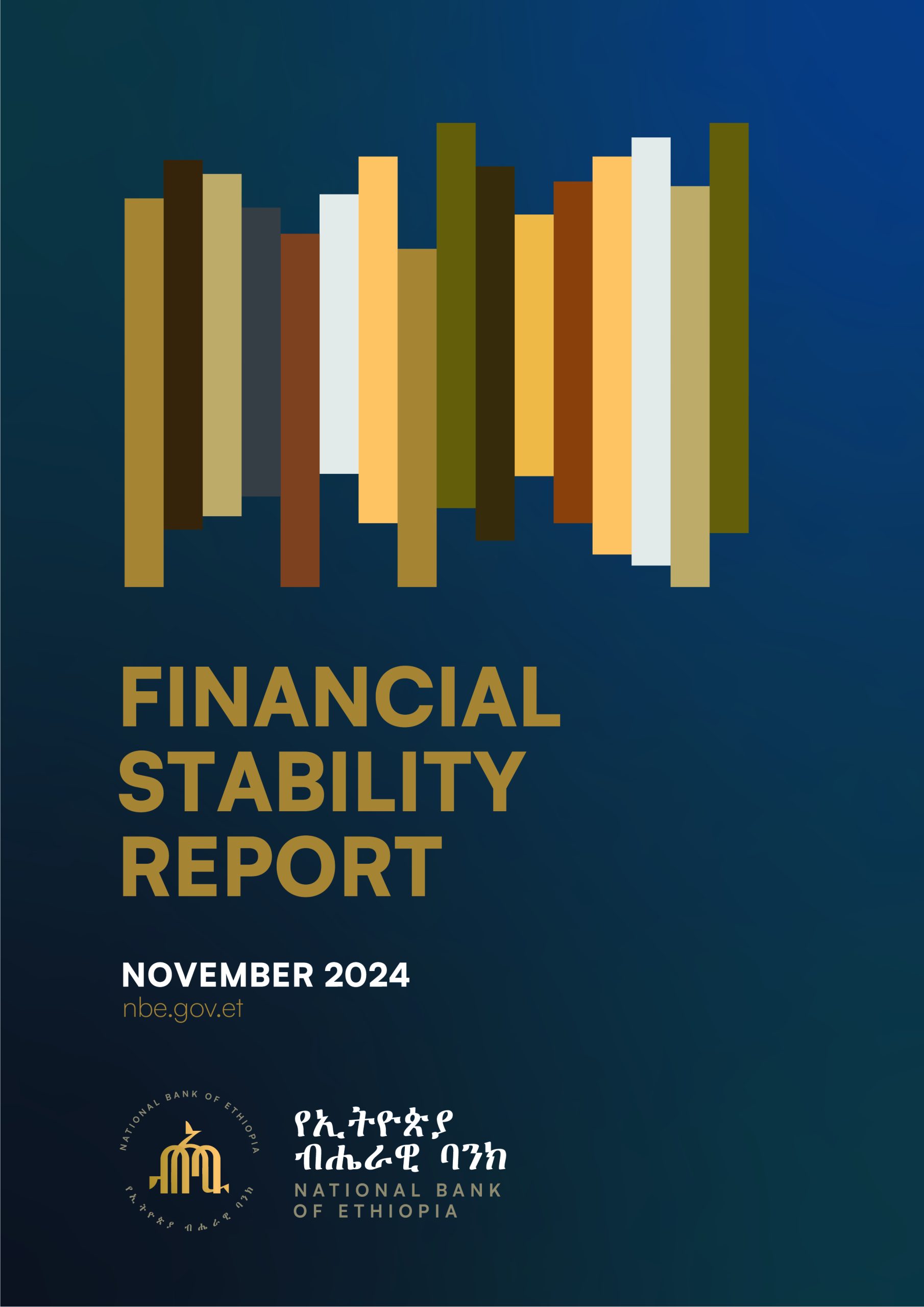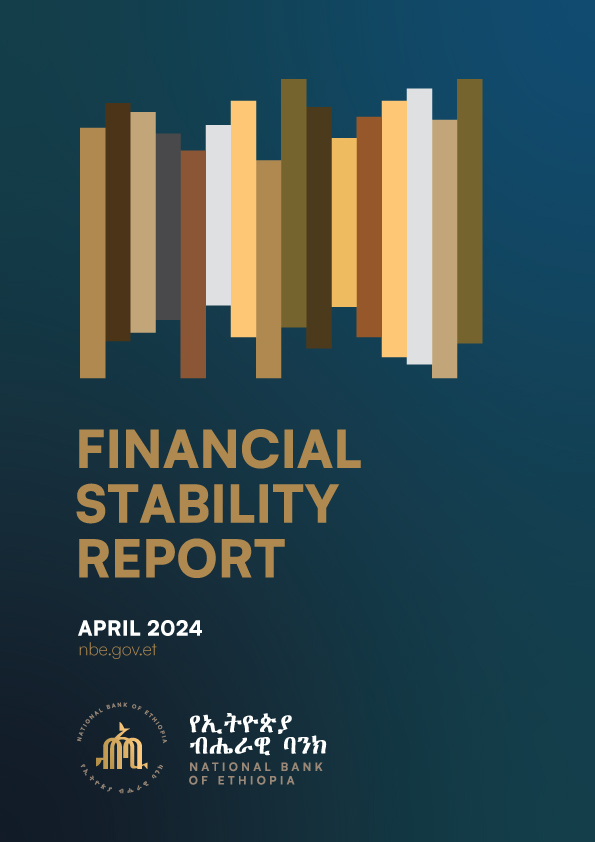NATIONAL BANK OF ETHIOPIA ISSUES SECOND FINANCIAL STABILITY REPORT
30 November 2024 | Addis Ababa, Ethiopia
National Bank of Ethiopia (NBE) is hereby issuing Ethiopia’s second Financial Stability Report examining developments and risks in the financial sector and the broader economy during the course of July 2023 – June 2024. The report also addresses the major reforms taking effect in the period July to September 2024 and provides an outlook on issues potentially affecting the stability of Ethiopia’s financial system in the remainder of this year and in 2025.
Banking continued to dominate the broader financial sector, with the former’s total assets accounting for 96.1 percent of the latter’s total assets at the end of June 2024. This implies the Ethiopian financial system’s stability largely depends on the health of its banking sector.
During the reporting period Ethiopia’s banking sector remained stable and resilient. Risks were mostly moderate and stable, although the outlook overall points to increasing risk levels for financial institutions due to external and domestic developments. Nevertheless, the systemic risk level remains limited. Credit risk is lower than the high credit concentration suggests, because loans to the private sector are relatively diversified. In addition, the credit risk stress test shows that even a severe shock would not pose a systemic threat. The banking industry as a whole is also found to exhibit low liquidity risk and shows resilience to short-term liquidity shocks, despite some downside risks. Conversely, operational risks are significant in the banking industry and are expected to rise further in the short and medium term, with incidents of fraud, social engineering, insider threats, and third-party risks on the rise. With respect to market and foreign exchange risks, except for a few affected financial institutions, the banking sector has also performed well during its adjustment to the exchange rate reform in July 2024.
NBE directives have been issued in 2024 to reduce observed risks and to improve the resilience of banks to shocks in several areas. Beyond the system-wide risks, directives put in place recently by NBE have sought to prevent and contain risks in key areas. These include governance, asset classification, lending to individuals with significant influence, large exposures, and related party lending. NBE also continues to work with individual banks that are more exposed to these challenges and struggle to cope with bank-specific risks.
Noteworthy reforms to further strengthen the stability of the financial sector have also been implemented during the year. They include the transition to an interest-rate based monetary policy regime involving the use of Open Market Operations (OMOs), the liberalization of the exchange rate regime, the reform of the Commercial Bank of Ethiopia through restructuring and recapitalization, and the further development of the digital payments ecosystem. In addition, there were reforms to develop the capital market ecosystem as well as legal and regulatory reforms to align banking practices with international best practices. With major fiscal, monetary, and exchange rate reforms put in place in recent months, there is a broadly positive macroeconomic outlook for 2024 – 2025.
The microfinance, capital goods leasing, and insurance business sectors have been analyzed and found to be sound overall, while outlook in these sectors remains positive in terms of growth, stability and resilience.
NBE publishes the financial stability report annually, in November of each year.
SEE PREVIOUS FINANCIAL STABILITY REPORT BELOW
National Bank of Ethiopia
Notes on the Launch of the Financial Stability Report
Upholding a sound and stable financial system in Ethiopia is one of the mandates of the National Bank of Ethiopia (NBE). This requires the assessment and addressing of risks that may affect financial sector stability, whether these risks originate within the financial sector itself or from other domestic or international developments. Considering this, the NBE is publishing its first Financial Stability Report (FSR) to inform key stakeholders about the NBE’s analysis and assessment of key risks as well as its recommendations to mitigate these identified risks. The report is based on an assessment of risks and stress tests undertaken for the 2022-23 fiscal year (the review period).
The main conclusion of the report is that while the systemic risk level of Ethiopia’s financial sector is low, some risks have increased in the most recent review period, and these warrant appropriate attention and preventive actions to ensure the continued safety and soundness of the financial system.
- In the banking sector, overall risks are judged to be moderate. At the same time, credit, liquidity, operational, and, to a lesser degree, market risks increased during the review period. Nevertheless, banks have remained sound and stable due to strong capital and liquidity buffers, solid profitability, and other factors (see Figure). These factors contribute to the resilience of banks to various potential shocks, as indicated by the risk stress tests performed by the NBE.
- In the microfinance sector, the capital adequacy ratio, non-performing loan ratio, and liquidity ratio are all well within the NBE’s parameters and have improved over the course of the review period.
- The capital goods finance business sector’s risk rating is moderate, with low capital risk and moderate ratings for asset quality and systemic risk.
- The insurance sector remains resilient, but earnings and concentration risks are rated high and may call for regulatory actions.
- Across the industry, credit and deposit concentration risks are found to be high, an area that warrants close oversight as well as potential regulatory intervention.
- With respect to Ethiopia’s financial sector infrastructure, there have been substantial improvements in recent years, but some areas remain underdeveloped. It requires further improvements in structural, operational, and technical efficiencies. A more refined and explicit standard for risk assessment in the rapidly evolving space of digital finance is one of the key areas requiring policy attention, as well as the implementation—in partnership with industry players—of risk mitigation strategies and interventions.
As the FSR is the first report of its kind prepared by the NBE, special care was taken in its preparation, and the views of peers with ample experience in preparing such reports were sought and incorporated into the report. As a result, it has taken longer than initially planned to publish the report. Future Financial Stability Reports will be published annually, with the aim of having them completed by November of each year, covering the previous fiscal year. The next edition is thus planned to be published before the end of 2024.


